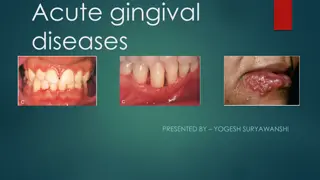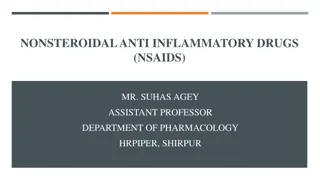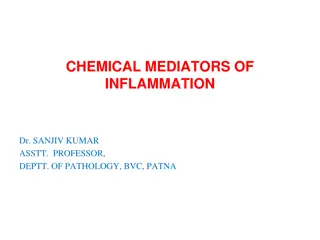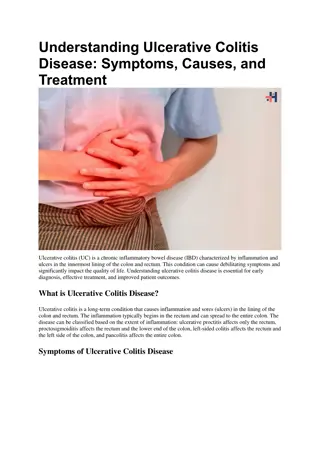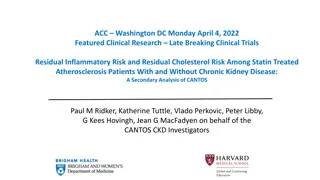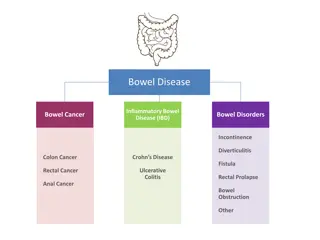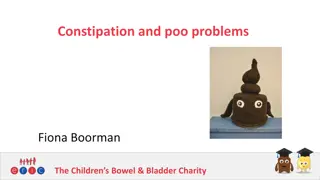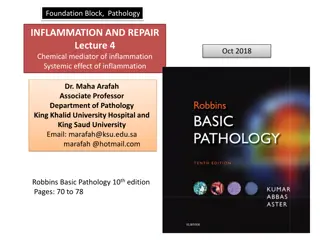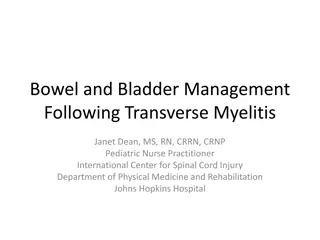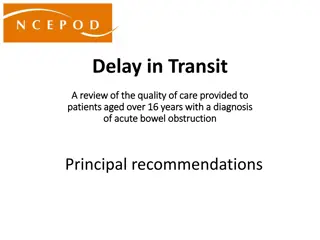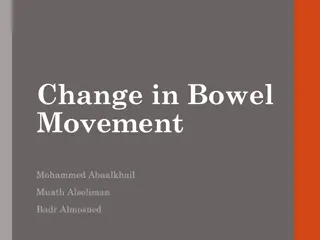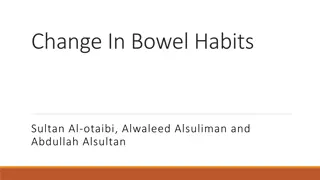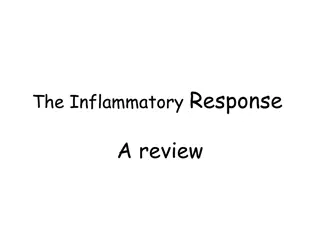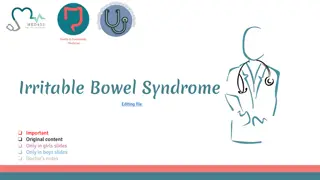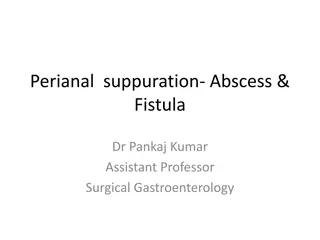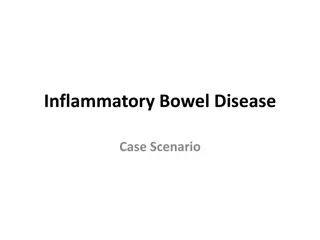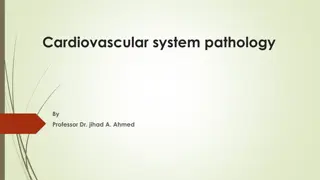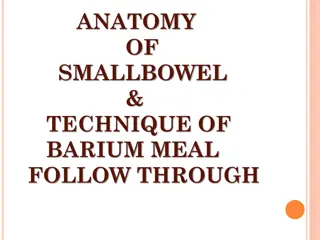Understanding Inflammatory Bowel Disease: Crohn's Disease and Ulcerative Colitis
Inflammatory Bowel Disease (IBD) encompasses Crohn's disease (CD) and ulcerative colitis (UC), chronic conditions with immunologic basis. This article delves into the epidemiology, pathophysiology, and differences between CD and UC, highlighting clinical features, pathology, and complications like adenocarcinoma. Factors like ethnicity, age, and smoking influence disease incidence. The hygiene hypothesis proposes a link between improved hygiene and increased IBD prevalence due to altered immune responses.
Download Presentation

Please find below an Image/Link to download the presentation.
The content on the website is provided AS IS for your information and personal use only. It may not be sold, licensed, or shared on other websites without obtaining consent from the author. Download presentation by click this link. If you encounter any issues during the download, it is possible that the publisher has removed the file from their server.
E N D
Presentation Transcript
Gastrointestinal Block Pathology lecture Dec, 2017 Inflammatory bowel disease Dr. Maha Arafah Dr. Ahmed Al Humaidi
Learning Objectives 1. Know the two forms of idiopathic inflammatory bowel disease (IBD). 2. Compare and contrast Crohn s disease and Ulcerative Colitis with respect to: a. clinical features and extraintestinal manifestations b. pathogenesis c. pathology (gross and microscopic features) d. complications (especially adenocarcinoma preceded by dysplasia)
Inflammatory Bowel Diseases Inflammatory bowel disease (IBD) is a chronic condition resulting from inappropriate mucosal immune activation Crohn's disease (CD) and ulcerative colitis (UC) Ulcerative colitis is the common inflammatory bowel disease Although their causes are still not clear, the two diseases probably have an immunologic hypersensitivity basis.
Epidemiology Both Crohn s disease (CD) and ulcerative colitis (UC) are more common in females and in young adults Ulcerative colitis More common in whites than blacks Occurs between 14 and 38 years of age Lower incidence in smokers and other nicotine users Lower incidence if previous appendectomy <20 years Crohn s disease More common in whites than blacks, in Jews than non-Jews. More common in children than adults. Smoking is a risk factor Majority (>75%) of cases occur between 11 and 35 years of age
Epidemiology The geographic distribution of IBD is highly variable, but it is most prevalent in North America, northern Europe, and Australia. IBD incidence worldwide is on the rise and is becoming more common in regions in which the prevalence was historically low.
Epidemiology The hygiene hypothesis suggests that these changes in incidence are related to: improved food storage conditions and decreased food contamination. improved hygiene has resulted in inadequate development of regulatory processes that limit mucosal immune responses early in life. As a result, exposure of susceptible individuals to normally innocuous microbes later in life triggers inappropriate immune responses due to loss of intestinal epithelial barrier function.
Pathophysiology luminal bacteria
Pathophysiology 1. Defects in host interactions with intestinal microbes 2. Intestinal epithelial dysfunction 3. Aberrant mucosal immune responses. For unclear reasons, research suggests that smoking increases the risk of Crohn s disease but reduces the likelihood of ulcerative colitis. UC
Pathophysiology Genetics: mutation in Nucleotide-binding oligomerization domain-containing protein 1 (encodes a protein that binds to intracellular bacterial peptidoglycans) NOD2 . susceptibility gene in Crohn disease. . Abnormal recognition and response to intracellular pathogens Less effective at recognizing and combating luminal microbes Mucosal immune responses. Abnormal intestinal epithelial tight junction barrier function Transepithelial flux of luminal bacterial components activates immune responses Inflammation
Clinical The manifestations of IBD generally depend on the area of the intestinal tract involved. Extraintestinal manifestations Colon Small intestine Arthritis Eye manifestation Skin manifestation Bloody diarrhea, Tenesmus Abdominal pain Intestinal obstruction. Steatorrhea
Crohn's disease is a chronic inflammatory disorder that most commonly affects the ileum and colon but has the potential to involve any part of the gastrointestinal tract from the mouth to the anus.
Crohn's disease Clinical Features Any age but has its highest incidence in young adults Extremely variable clinical feature. Acute phase: fever, diarrhea, and right lower quadrant pain may mimic acute appendicitis. Chronic disease: remissions and relapses over a long period of time. Thickening of the intestine may produce an ill- defined mass in the abdomen.
Crohn's disease Sites of Involvement: Any part of the GIT from the mouth to the anus. ileum (30%) colon (20%). most commonly terminal ileum Commonly (75%) have perianal lesions such as abscesses, fistulas, and skin tags.
Crohn's disease Gross Appearance: Involvement is typically segmental, with skip areas of normal intestine between areas of involved bowel. Marked fibrosis causing luminal narrowing with intestinal obstruction. Fissures (deep and narrow ulcers that look like stabs with a knife that penetrate deeply into the wall of the affected intestine) fistulas (communications with other viscera).
Mucosa: longitudinal serpiginous ulcers separated by irregular islands of edematous mucosa. This results in the typical cobblestone effect.
FAT : In involved ileal segments, the mesenteric fat creeps from the mesentery to surround the bowel wall (creeping fat)
Crohn's disease Microscopic Features 1. Distortion of mucosal crypt architecture with mucosal inflammation 2. Transmural inflammation 3. Epithelioid granulomas [60%] Fissure-ulcers and fistulas can be seen microscopically
Normal Crohn s Disease FISSURE GRANULOMA
Crohn's disease Clinical findings Recurrent right lower quadrant colicky pain (obstruction) with diarrhea and weight loss Bleeding occurs only with colon or anal involvement (fistulas; abscesses) Aphthous ulcers in mouth Extragastrointestinal: erythema nodosum, sacroiliitis (HLA-B27 association), pyoderma gangrenosum, iritis (CD > UC), primary sclerosing cholangitis (UC > CD)
Crohn's disease Complications 1. Intestinal obstruction 2. Fistula formation a) between the ileum and the colon result in malabsorption b) Enterovesical fistulas lead to urinary infections and passage of gas and feces with urine. c) Enterovaginal fistulas produce a fecal vaginal discharge. 3. Extraintestinal manifestations (arthritis and uveitis) 4. Slight increased risk of development of carcinoma of the colon much less than in ulcerative colitis.
Crohn's disease Summary Involvement of discontinuous segments of intestine (skip areas Can involve any part of GIT. Noncaseating epithelioid cell granulomas Transmural (full-thickness) inflammation of the affected parts
Ulcerative Colitis Definition chronic relapsing ulceroinflammatory disease of undetermined etiology 20- to 30-year age group but may occur at any age Most common inflammatory bowel disease Ulcerations are in continuity
Ulcerative Colitis Etiology The cause is unknown Antibodies that cross-react with intestinal epithelial cells and certain serotypes of Escherichia coli have been demonstrated in the serum of some patients with ulcerative colitis.
Ulcerative Colitis Clinical Features In the acute phase and during relapse, the patient has fever, leukocytosis, lower abdominal pain, bloody diarrhea and mucus in the stool. The disease usually has a chronic course, with remissions and exacerbations.
Ulcerative Colitis Sites of Involvement Ulcerative colitis is a disease of the rectum, and the colon. Rectum is involved in almost all cases The disease extends proximally from the rectum in a continuous manner without skip areas. The ileum is not involved as a rule
Ulcerative Colitis Gross Appearance Involves mainly the mucosa (diffuse hyperemia with numerous superficial ulcerations in the acute phase. The regenerated or nonulcerated mucosa may appear polypoid (inflammatory pseudopolyps) in contrast with the atrophic areas or ulcers.
diffuse hyperemia with numerous superficial ulcerations NO skip lesion
Ulcerative Colitis Microscopic Appearance The inflammation is usually restricted to the mucosa. In the active phase .neutrophils (Cryptits, crypt abscess) In the chronic phase ..crypt atrophy and distortion Active inflammation correlates well with the severity of symptoms.
The inflammation is usually restricted only to the mucosa. inflammation No inflammation
Crypt abscess dysplasia
Ulcerative Colitis Clinical findings Recurrent left-sided abdominal cramping with bloody diarrhea and mucus Fever, tenesmus, weight loss Toxic megacolon (up to 10% of patients). Mortality rate 50%. Extra-gastrointestinal: primary sclerosing cholangitis (UC > CD), erythema nodosum, iritis/uveitis (CD > UC), pyoderma gangrenosum, HLA-B27 positive arthritis. p-ANCA antibodies >45% of cases
Ulcerative Colitis Extraintestinal manifestations 1. Arthritis 2. Uveitis 3. Skin lesions (pyoderma gangrenosum), 4. Sclerosing cholangitis (fibrosis around bile ducts), leading to obstructive jaundice.
Ulcerative Colitis Complications Acute phase 1. Severe bleeding 2. Toxic megacolon ( dilation of the colon, with functional obstruction) Chronic ulcerative colitis Increase risk of developing colon carcinoma. The presence of high-grade dysplasia in a mucosal biopsy imposes a high risk of cancer and is an indication for colectomy.
Crohn's disease Ulcerative Colitis Any part of the GIT Colon only Site Skip areas of normal mucosa Diffuse involvement of mucosa Pattern Deep ulcers ( fissure ) Superficial ulcers Depth of the ulcer Transmural inflammation Mucosal inflammation only Extent of inflammation Fistula formation Yes No Creeping mesenteric fat Yes No Fibrous thickening of wall Yes No Granulomas Yes No Dysplasia rare Common Carcinoma more common (10%) rare Mucosal appearances Pseudopolyps Cobblestone Bowel wall Thin wall Dilated lumen Thickened wall Narrow lumen Lymphoid reaction Moderate Marked Complications Short gut syndrome Fistula formation Bowel perforation Stricture formation Haemorrhage Electrolyte loss Toxic megacolon Systemic effects
Crohn's disease Ulcerative Colitis Any part of the GIT Colon only Site Skip areas of normal mucosa Diffuse involvement of mucosa Pattern Deep ulcers ( fissure ) Superficial ulcers Depth of the ulcer Transmural inflammation Mucosal inflammation only Extent of inflammation Fistula formation Yes No Creeping mesenteric fat Yes No Fibrous thickening of wall Yes No Granulomas Yes No Dysplasia rare Common Carcinoma more common (10%) rare Mucosal appearances Pseudopolyps Cobblestone Bowel wall Thin wall Dilated lumen Thickened wall Narrow lumen Lymphoid reaction Moderate Marked Complications Short gut syndrome Fistula formation Bowel perforation Stricture formation Haemorrhage Electrolyte loss Toxic megacolon Systemic effects Recurrence after surgery Common No
Inflammatory bowel diseases MATCH 1. 2. 3. 4. 5. 6. 7. 8. 9. 10. Deep ulcers ( fissure ) 11. Dysplasia is common 12. Carcinoma is more common (10%) Colon only Diffuse involvement of mucosa Superficial ulcers Any part of the GIT Skip areas of normal mucosa Mucosal inflammation only Fistula formation Transmural inflammation Granulomas A. Crohn's disease B. Ulcerative Colitis


